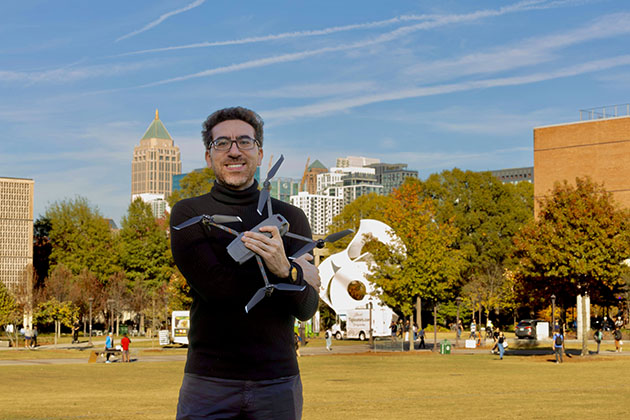Georgia Tech Startup Targets Building Energy Inefficiencies With AI and Drones
Lamarr.AI raised $1.1 million to bring its innovative building diagnostics technology to market.

Making buildings environmentally sustainable is a major thrust of Lamarr.AI. The startup leverages advances in drones, thermal imaging, and AI to autonomously detect building defects. Georgia Tech Associate Professor Tarek Rakha co-founded Lamarr.AI to apply this research and scale it across the U.S. and the globe. (Photo credit: Wes McRae, Georgia Tech)
Buildings are big energy consumers, emitting wasteful carbon, contributing to a warming planet, and accounting for more than 40% of the world’s carbon dioxide emissions.
The culprits behind this hefty energy hit are two distinct sources of carbon: the building construction process and a building’s operation and use.
Fortunately, a new startup is paving the way for dramatic reductions in carbon from building operations. Lamarr.AI has perfected the process of using drones, thermal imaging, and artificial intelligence (AI) to diagnose the health of building exteriors and roofs.
The young company — named for Hedy Lamarr, the actor and inventor credited with helping birth the modern telecommunications era — offers an autonomous solution to diagnose a building’s energy footprint. Lamarr.AI is a spin-off from Georgia Tech, Massachusetts of Technology (MIT), and Syracuse University.

Finding Energy Issues Autonomously
A Lamarr.AI drone flies over a building. (Photo credit: Tarek Rakha)
“Our service is akin to giving your building an MRI scan. It will revolutionize health monitoring for the built world,” said Tarek Rakha, Lamarr.AI CEO and associate professor in Georgia Tech’s School of Architecture. “We actually diagnose the root cause of a building envelope’s defects, map them out on 3D models, and translate them to an energy simulation to quantify lost energy.”
According to the Department of Energy, the U.S. wastes $100 billion in energy due to ineffective building envelopes, which are the shell, or barrier, between a building’s interior and the outdoors.
An expert on computer-vision drones, urban energy sensing, and computation informatics, Rakha currently directs Georgia Tech’s High Performance Building Lab. He collaborated on Lamarr.AI’s development and commercialization with Syracuse University’s Senem Velipasalar and MIT’s Norhan Bayomi and John E. Fernández. Together, the three universities co-own two patents based on Lamarr.AI’s technology.
In October 2024, the company raised $1.1 million in pre-seed funding to bring its building diagnostics technology to market. Hazelview Ventures, the venture capital arm of global real estate firm Hazelview Investments, led the funding round. Other investors include milemark•capital, Newlab, Georgia Tech Foundation Ventures, and MIT’s SBXi Fund.
To date, Lamarr.AI has worked with significant players in the healthcare, higher education, multi-family, residential office building, and industrial warehouse sectors to help building owners identify targeted, cost-effective repairs that save energy.
“I’m very happy with the response we’ve gotten as a very young startup — already making revenue,” said Rakha. He attributes this positive reception to Lamarr.AI’s solution being “cheaper, faster, more accurate, and safer” than the regular means of inspecting a building’s envelope.
Michael Williams, Hazelview Investments managing partner and head of development, said that Lamarr.AI first piqued his interest because of its use of AI and its hyperfocus on building envelopes, which are costly and time-consuming to inspect.
“Having the ability to automate that process and make it a little bit easier on a national scale was extremely compelling to us,” Williams said. “It’s going to have a tremendous impact and will be a game-changer if they continue to evolve the product.”
“Our service is akin to giving your building an MRI scan. It will revolutionize health monitoring for the built world.”— Tarek Rakha


